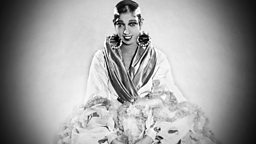Josephine Baker - More Than Meets the Eye

By Michell Chresfeld
The third episode of the new series, Makeup: A Glamourous History delves into how Josephine Baker revolutionised ideas about tanned skin and beauty culture in the 1920s. Dancer, singer, actress, and beauty icon—very few are unfamiliar with Baker’s pin curls, café au lait skin, and banana skirt. Dubbed the ‘Nefertiti of Now’ by Pablo Picasso, Baker took the world by storm with her seductive danse sauvage which debuted in Paris in 1925. Baker became an immediate sensation as women all over Europe sought to emulate her iconic flapper style. Baker would capitalise on this interest by marketing her own brand of suntan oil called Bakeroil, which promised to give women walnut skin. She would also release Bakerfix, a hair pomade that promised to give customers her famous ‘Eton crop’, a short face-framing cut featuring glistening curls pasted to the cheeks and forehead.
Yet, Baker was not only a style and beauty icon of the 1920s she remains a notable inspiration for modern superstars like Beyoncé, and singer-turned-makeup mogul Rhianna. But beyond her stunning good looks, Baker was a revolutionary who challenged mainstream ideas of race and gender. Here are five little known facts about this indomitable figure.
Watch Makeup: A Glamourous History on Tuesday 4 May, BBC Two, 9pm and on BBC iPlayer.
Baker faced a tough start
Though she would achieve international acclaim Baker came from very humble beginnings and experienced a tumultuous childhood. Baker was born Freda Josephine McDonald on 6 June 1906 in St. Louis Missouri. Baker experienced precarity throughout her early childhood and as a child worked as a live in domestic in order to support her family. At age 11 Baker witnessed the violent East St. Louis Massacre, which began as a labour dispute after white employees of the city’s meatpacking industry went on strike, only to be replaced by black workers. After a three-day crisis of in which white workers attacked black residents, at least 39 African Americans were left dead and thousands more were burned out of their homes. This early example of racial hatred would forever shape Baker’s commitment to combatting racism.
Baker owned an impressive menagerie
A lover of pets since childhood, Baker collected several exotic animals throughout her storied life. Chiquita the cheetah, who was originally part of her dance act, was known for wearing a diamond collar and leaping into the conductor’s pit during performances. Baker also adopted a pig named Albert that she would dress up and spray with perfume. Baker’s menagerie also included a pet snake named Kiki, a chimpanzee, a parrot, two goldfish, and several dogs.
She was a spy
Baker worked as a spy for the Allied forces during WWII. Though some accounts claim that the French resistance trained Baker as a shooter, her primary role was to gather intelligence and transport messages. As a performer Baker routinely traveled with sheet music. These circumstances allowed her to transport dozens of hidden messages written in invisible ink. She is also believed to have carried concealed notes and photographs pinned to her undergarments. As a star of world renown Baker largely escaped the surveillance of the Axis powers. However, there was one particularly close call involving Nazi agents searching her home when she had several members of the resistance hiding in her basement. For her bravery Baker was awarded the Cross of Lorraine by Charles de Gaulle in 1943. In 1961 she was awarded the Legion of Honor and the Croix de Guerre.
Baker was a civil rights activist
Baker used her role as a performer to combat racism and facilitate racial harmony, and for these reasons refused to perform for segregated audiences. Despite a successful 1951 tour where she integrated establishments in Las Vegas and Miami, Baker continued to face racism. While out to dinner at New York’s elite Stork Club waiters refused to serve Baker after she ordered a steak, claiming that they had run out. The waiter also claimed to have run out of every other menu item Baker ordered, despite those items being available for white patrons. Incensed, Baker called the police and accused the establishment of racism bringing a host of bad publicity to the club. The Stork Club incident came on the heels of Baker’s other high-profile demonstrations against racial injustice. Not only did she attempt to integrate a whites-only water fountain in Washington DC, but she also urged white business leaders to hire more African Americans. Baker’s efforts would eventually land her on an FBI list for political dissidents and she would be barred from entering the United States for over a decade. However, in 1963 Baker would make a triumphant return as the only woman to give a speech at the historic March on Washington. Wearing her French military uniform, Baker spoke about the need to carry on the fight for racial equality.
She was mum to ‘The Rainbow Tribe’
Baker took her commitment to racial solidarity one step further when she adopted 12 children-10 boys and 2 girls from Algeria, Belgium, Columbia, Finland, France, Japan, and Venezuela-to create a living example of racial harmony she called her ‘Rainbow Tribe’. On the grounds of her 15th century French chateau called Les Milandes, Baker charged admission to visitors who could pay to see the children singing, dancing, and playing together. Though it is hard to ignore the voyeuristic aspects of Baker’s racial utopia, she intended her multiracial and multinational family to serve as a political testament that love could transcend difference.
